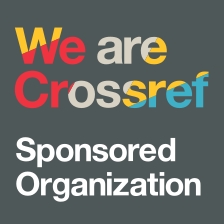The Culture of “Hijabers” Top Class in Social Media: Counter Hegemony or Next Hegemony?
(Netnographic Study on the Instagram Accounts of Dian Pelangi and Dato' Seri Vida)
Abstract
This article will discuss how Muslim women currently support their Islamic views through clothing that has been constructed in such a way. One of them is the phenomenon of "hijabers" among high-ranking Muslims as if confirming a new identity that is considered Muslim but still "current". Mastery in this discussion refers to a number of artists or public figures who also share their style and fashion via social media to fans. Making this kind of domination of upper-middle class Muslims over other class Muslim women. However, on the one hand, the use of the hijab as part of eastern culture is actually gaining ground again in line with people's desire to be religious but still trendy. So the hegemony that occurs can be said to be without coercion and is a necessity. However, on the other hand, this mastery is also a serious problem to be observed because the stigma that appears appears to be too luxurious and excessive due to the addition of "wow" accessories and the Western elements that are tried to be included.
References
Attamimi, N. (2015). Hegemoni dalam Komunikasi: Sebuah Analisis atas Arus Komunikasi dan Informasi. Jurnal Politika, 1, 78–86.
Bennett, T., Savage, M., Silva, E., Warde, A., Gayo-Cal, M., & Wright, D. (2008). Culture, Class, Distinction (1st ed.). Routledge.
Beta, A. R. (2014). Hijabers: How Young Urban Muslim Women Redefine Themselves in Indonesia. International Communication Gazette, 76(4–5), 377–389. https://doi.org/10.1177/1748048514524103
Bullingham, L., & Vasconcelos, A. C. (2013). “The Presentation of Self in The Online World”: Goffman and The Study of Online Identities. Journal of Information Science, 39(1), 101–112. https://doi.org/10.1177/0165551512470051
Carroll, W. K. (2009). Hegemony, Counter-hegemony, Anti-hegemony 1.
Eckersall, P., Grehan, H., & Scheer, E. (2017). New Media Dramaturgy: Performance, Media, and New Materialism. Palgrave Macmillan. http://www.springer.com/series/14742
Ekers, M., Loftus, A., & Mann, G. (2009). Gramsci Lives! Geoforum, 40(3), 287–291. https://doi.org/10.1016/j.geoforum.2009.04.007
Goodman, J., & Salleh, A. (2013). The “Green Economy”: Class Hegemony and Counter-Hegemony. Globalizations, 10(3), 411–424. https://doi.org/10.1080/14747731.2013.787770
Gramsci, A. (1988). Selections from Political Writings 1910-1920 (Q. Hoare, Ed.). Lawrence & Wishart Limited.
Hall, S. (1985). Signification, Representation, Ideology: Althusser and The Post‐Structuralist Debates. Critical Studies in Mass Communication, 2(2), 91–114. https://doi.org/10.1080/15295038509360070
Ibrahim, I. S., & Akhmad, B. A. (2014). Komunikasi & Komodifikasi: Mengkaji Media dan Budaya dalam Dinamika Globalisasi: Vol. I (1st ed.). Yayasan Pustaka Obor Indonesia.
Khomalia, I., & Rahman, K. A. (2018). Micro Hijabers Celebrity: Membentuk Identitas dengan Update Self-Story via Instagram (Kasus Dian Pelangi). NALAR: Jurnal Peradaban Dan Pemikiran Islam, 2(1), 33. https://doi.org/10.23971/njppi.v2i1.869
Muno, W., & Brand, A. (2014). Farewell to leadership? Ideas of hegemony and counter-hegemony in the Americas. International Area Studies Review, 17(4), 375–393. https://doi.org/10.1177/2233865914550728
No Name. (2017, September 22). Sosialita Malaysia Mandi Uang di Bathtub Dihujat: Duit Tak Dibawa ke Kuburan. https://hot.detik.com/celeb/d-3653594/sosialita-malaysia-mandi-uang-di-bathtub-dihujat-duit-tak-dibawa-ke-kuburan
Potter, J. (2012). Advance Praise for Digital Media and Learner Identity. Palgrave Macmillan.
Quintero-Rivera, Á. G. (2011). Cultural struggles for hegemony: Salsa, migration, and globalization. Latin American Perspectives, 38(2), 58–70. https://doi.org/10.1177/0094582X10388623
Stephen, M. D. (2009). Alter-globalism as counter-hegemony: Evaluating the “postmodern prince.” Globalizations, 6(4), 483–498. https://doi.org/10.1080/14747730903298819
Zhang, X., & Guo, Z. (2012). Hegemony and counter-hegemony: The politics of dialects in TV programs in China. Chinese Journal of Communication, 5(3), 300–315. https://doi.org/10.1080/17544750.2012.701421
Copyright (c) 2023 Translitera : Jurnal Kajian Komunikasi dan Studi Media

This work is licensed under a Creative Commons Attribution-NonCommercial-ShareAlike 4.0 International License.
Authors who publish with this journal agree to the following terms:
- Copyright on any article is retained by the author(s).
- Author grant the journal, right of first publication with the work simultaneously licensed under a Creative Commons Attribution License that allows others to share the work with an acknowledgement of the work’s authorship and initial publication in this journal.
- Authors are able to enter into separate, additional contractual arrangements for the non-exclusive distribution of the journal’s published version of the work (e.g., post it to an institutional repository or publish it in a book), with an acknowledgement of its initial publication in this journal.
- Authors are permitted and encouraged to post their work online (e.g., in institutional repositories or on their website) prior to and during the submission process, as it can lead to productive exchanges, as well as earlier and greater citation of published work.
- The article and any associated published material is distributed under the Creative Commons Attribution-ShareAlike 4.0 International License










